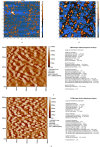Green synthesis of titanium dioxide nanoparticles with volatile oil of Eugenia caryophyllata for enhanced antimicrobial activities
- PMID: 30095433
- PMCID: PMC8676119
- DOI: 10.1049/iet-nbt.2017.0139
Green synthesis of titanium dioxide nanoparticles with volatile oil of Eugenia caryophyllata for enhanced antimicrobial activities
Abstract
Different chemo-physical methods are used to synthesise titanium oxide nanoparticles (TiO2 NPs), which are often expensive, unfriendly to the environment, toxic, not biocompatible, with a small yield. To resolve these problems, the researchers use green procedures to synthesise TiO2-NPs by plant extracts of Capsicum annum L. and Allium cepa (onion) and characterise using atomic force microscopy, scanning electron microscopy, transmission electronic microscopy, X-ray diffraction, ultraviolet (UV)-visible (Vis) spectra and Fourier transform infrared spectroscopy. The results indicate that most NPs synthesised by the first and second procedures of onion had an average diameter of 95.7 and 89.1 nm, while NPs synthesised by C. annum had an average diameter of 103.60 and 90.07 nm, respectively. In UV-Vis spectra, strong absorption was below 470 nm, and energy gap was 3.3 eV in each of the first procedure of A. cepa and the second procedure of C. annum compared with 270 nm, 6.3 eV for each of the second procedure of A. cepa and the first procedure of C. annum. The antimicrobial activities of NPs were evaluated and an attempt was made to enhance these activities by Eugenia caryophyllata plant's oil in combination therapies. There were synergistic effects between NPs and plant's oil.
Figures










References
-
- Milind P. Deepa K.: ‘Clove: a champion spice’, Int. J. Res. Ayurveda Pharmacy, 2011, 2, (1), pp. 47 –54
-
- Daniel A.N. Sartoretto S.M. Schmidt G. et al.: ‘Anti‐inflammatory and antinociceptive activities of eugenol essential oil in experimental animal models’, Braz. J. Pharmacognosy, 2009, 19, (1B), pp. 212 –217
-
- Khare C.P.: ‘Indian medicinal plants: an illustrated dictionary’ (Springer‐Verlag; Berlin/Heidelberg: 2007), p. 836
-
- Joshi B. Sah G.P. Basnet B.B. et al.: ‘Phytochemical extraction and antimicrobial properties of different medicinal plants: Ocimum sanctum (Tulsi), Eugenia caryophyllata (Clove), Achyranthes bidentata (Datiwan) and Azadirachta indica (Neem)’, J. Microbiol. Antimicrobials, 2011, 3, (1), pp. 1 –7
-
- Fagere Z.O. Al Magbou A.Z.: ‘Antibacterial activity of clove oil against some microorganisms at Khartoum state, Sudan’, Adv. Med. Plant Res., 2016, 4, (4), pp. 122 –128
Publication types
MeSH terms
Substances
LinkOut - more resources
Full Text Sources
Other Literature Sources
Miscellaneous

